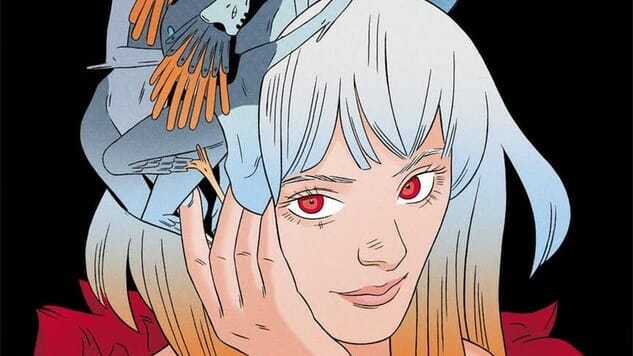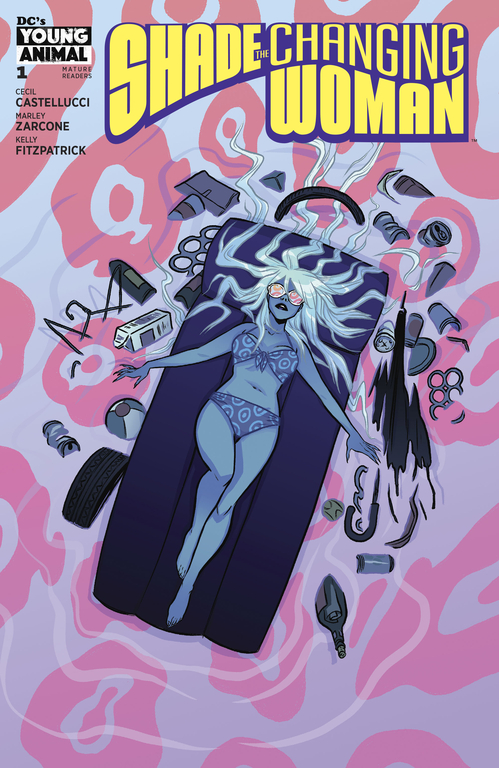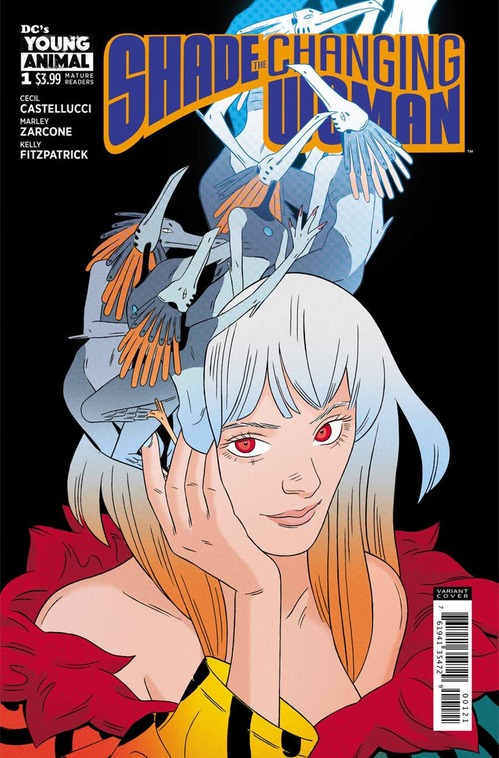Cecil Castellucci on Shade, the Changing Girl’s Growth Into Shade, The Changing Woman
Main Art by Marley Zarcone & Kelly Fitzpatrick
A lot has changed since the Gerard Way-curated Young Animal imprint started putting books on shelves a year and a half ago. The comic industry has weathered a series of serious storms that range from harassment and abuse to the failures of the direct market, and the world writ large feels like an entirely different place than it was in September 2016. Shade, the Changing Woman #1 embraces all of that chaos in a way few characters and even fewer creative teams can, reintroducing readers to a character who’s not the same as she was when we last saw her—but is still unquestionably herself.
Although it’s been only a few months since Shade, the Changing Girl #12 was published, two years have passed in Loma Shade’s world. As she settles into her new body, Shade continues to try to figure out what it means to be herself. She talks to new friends and old ones, masquerading as Megan and following Teacup and River from her high school days as they go off to college and into a new stage of their own lives. There’s a melancholy to Shade’s story, but a lot of sweetness and heart, too. The creative team has captured the nearly universal feeling of being lost in the world and in your own identity as you try to figure out the type of person you want to be. Artist Marley Zarcone and colorist Kelly Fitzpatrick have made some changes to Shade’s appearance and the way the world looks around her, from a haircut and a costume change to a modified color palette that feels harder and shaper, but not necessarily darker. Writer Cecil Castellucci is leaning into the stances she took in Shade’s guest appearance in the “Milk Wars” crossover, and the book feels even stronger than before. For Shade’s fans from her girlhood, it’s a welcome return; for those who haven’t yet uncovered what a great book this is, now’s the perfect time to jump on, and we exchanged emails with Castelluci (with a guest appearance from Zarcone) to find out more about Shade’s journey from Girl to Woman.
![]()

Shade, the Changing Woman #1 Cover Art by Becky Cloonan
Paste: The change from Girl to Woman feels weighty and intentional, particularly on the heels of Shade’s appearance in the “Milk Wars” event. Is there a definitive moment when you think the transition from child to adult happens? In Shade’s case, do you think her body- and identity-hopping moved that point for her?
Cecil Castellucci: The “Milk Wars” kind of serves as an emotional bridge between Shade the Girl and Shade the Woman. That moment where you kind of sort out who you are and what you will become. At the end of Girl, Shade has a body. Her old self is dead. And I think that we all have moments like that in our lives. Who can tell when one really feels that they have made the transition from child to adult? I think for everyone it is different. And it is a continuing relationship with the self. I know I have said, Oh, now I’m a woman only to say it again a few years later. So there is no definitive answer, it’s personal. But for Shade, she has control over this new body and I think her time as Honey in the previous arc has affected her and how she sees the world. She’s coming into herself. She has to. There is nowhere else for her to go. This is the life she has to lead. That can ruin you and mature you.
Paste: Much of the journey that Shade is going through deals with questions of identity and agency in a way that is gendered, but largely universal. The “Life with Honey” pages often confronted the imbalanced expectations set on women more overtly than the main story did. On the other hand, the Shade, the Changing Girl/Wonder Woman Special felt like a far more targeted and undisguised statement about how women specifically are seen and treated. What prompted that shift?
Castellucci: I think that Shade’s experience of Earth with “Life with Honey” definitely influenced her point of view. As you know, Honey is what Loma thinks Earth is like and Honey, though 1950s-gendered, is a pretty radical woman. Secretly smart. Totally open. I think that flowed nicely into the Wonder Woman crossover. But you know, honestly, a lot has happened between the time that I started Shade and the time that the Wonder Woman crossover came up. When I was tasked with the mission to have Wonder Woman forget who she was, having her fall into a strange domestic and deeply archaic idea of womanhood seemed natural. I am a woman in this moment of time and I can’t help but comment on that. It was time to be bold and to put that front and center. To say, there is more than one kind of woman. There is every woman. Shade has the position of being an outsider who is trying to parse out what kind of a woman she wants to be. To have her be split and forced into a role was a natural way to have her rebel and become who she wants to be moving forward.
-

-

-

-

-

-

-

-

-

-

-

-

-

-

-

-

-

-

-

-

-

-

-

-

-

-

-

-

-

-

-

-

-

-

-

-

-

-

-

-









































